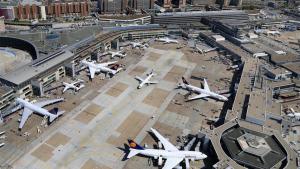Worldwide decline in air traffic growth
DLR Global Aviation Monitor
• The growth rate of global air traffic has fallen to just 1.5 percent per year.
• In Germany, growth has halted – there is a negative growth trend.
• Forecast – global growth in aircraft movements to remain subdued in the third quarter of 2019.
• Focus: Aeronautics, transport

Frankfurt Airport.
After many years of continued growth in global air traffic, with more and more flights, passengers and flight connections, a slowdown is now becoming apparent. The number of passenger aircraft movements worldwide increased by only 1.5 percent in June – from 3.3 million in June 2018 to just under 3.4 million in June of this year. This is shown by the current Global Aviation Monitor (GAM) issued by the German Aerospace Center (Deutsches Zentrum für Luft- und Raumfahrt; DLR), which covers 3500 airports and 850 airlines across the globe. For Germany, the study even shows a decline in air traffic of 1.7 percent.
Top three aviation markets – Asia, North America, Europe
With more than one million aircraft departures per month, Asia has been the world's largest air transport market for several years. Approximately 30 percent of all flights take place there. After years of strong growth, however, the number of aircraft movements in the emerging continent is only growing by two to three percent compared with the previous year. “The slowdown in growth momentum in Asia is having a particularly strong impact on the global slowdown in the number of flights and flight connections,” explains Peter Berster, Study Leader at the DLR Institute of Air Transport and Airport Research in Cologne. “Increasing economic uncertainties are playing a major role here.”
North America ranks second, with a total share of 27 percent of global air traffic. For some time now, only low growth rates of between two and three percent have been observed there. With 832,000 take-offs per month and a share of 24.7 percent, Europe ranks third worldwide. In the last two years, the European market has slipped from an initial growth rate of five percent to just 1.2 percent. “In Germany, the decline in 2017 caused by the bankruptcy of Air Berlin was followed by high growth rates in 2018,” explains Berster. “This enabled the resulting gap to be filled again.” At 87,900 departures per month, the current figures are now approximately 1.7 percent below the 89,400 monthly departures of June 2018.
For the third quarter of 2019, the DLR study predicts continued modest growth in flight movements – between one and two percent at the European and global level. In Germany, the researchers expect further stagnation.
Significantly more flights at Dusseldorf and Stuttgart
In June 2019, Dusseldorf and Stuttgart airports handled between two and four percent more flights than in June 2018. This increase is mainly due to the strong expansion of the services offered by Eurowings and easyJet from Dusseldorf and Laudamotion and easyJet from Stuttgart. Cologne-Bonn Airport also benefitted from an expansion by the British low-cost carrier easyJet, but also suffered a decline with Flybe, for example.
On the other hand, a negative trend can be observed at some smaller airports such as Weeze or Frankfurt-Hahn. The withdrawal of Ryanair from the smaller locations is leading to shrinking numbers of aircraft movements. “We notice that some low-cost carriers are increasingly concentrating on larger locations and withdrawing more and more from smaller airports,” says Berster.
Largest airlines are from the USA
In terms of the number of aircraft movements, American Airlines is the largest air carrier in the world, with more than 200,000 departures in June 2019 alone, followed by Delta Air Lines and United Airlines, all of which have grown strongly in the past due to acquisitions of other airlines. The low-cost carriers Southwest Airlines, Ryanair and easyJet follow in fourth, fifth and eighth place respectively. In between, the major Asian airlines China Eastern and China Southern are ranked sixth and seventh respectively. With IndiGo, JetBlue and Azul, other low-cost carriers from various continents are among the 25 largest airlines in the world.
Source: German Aerospace Center
- 249 reads
Human Rights
Fostering a More Humane World: The 28th Eurasian Economic Summi

Conscience, Hope, and Action: Keys to Global Peace and Sustainability

Ringing FOWPAL’s Peace Bell for the World:Nobel Peace Prize Laureates’ Visions and Actions

Protecting the World’s Cultural Diversity for a Sustainable Future

Puppet Show I International Friendship Day 2020

